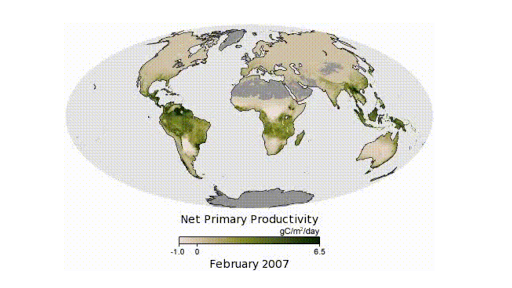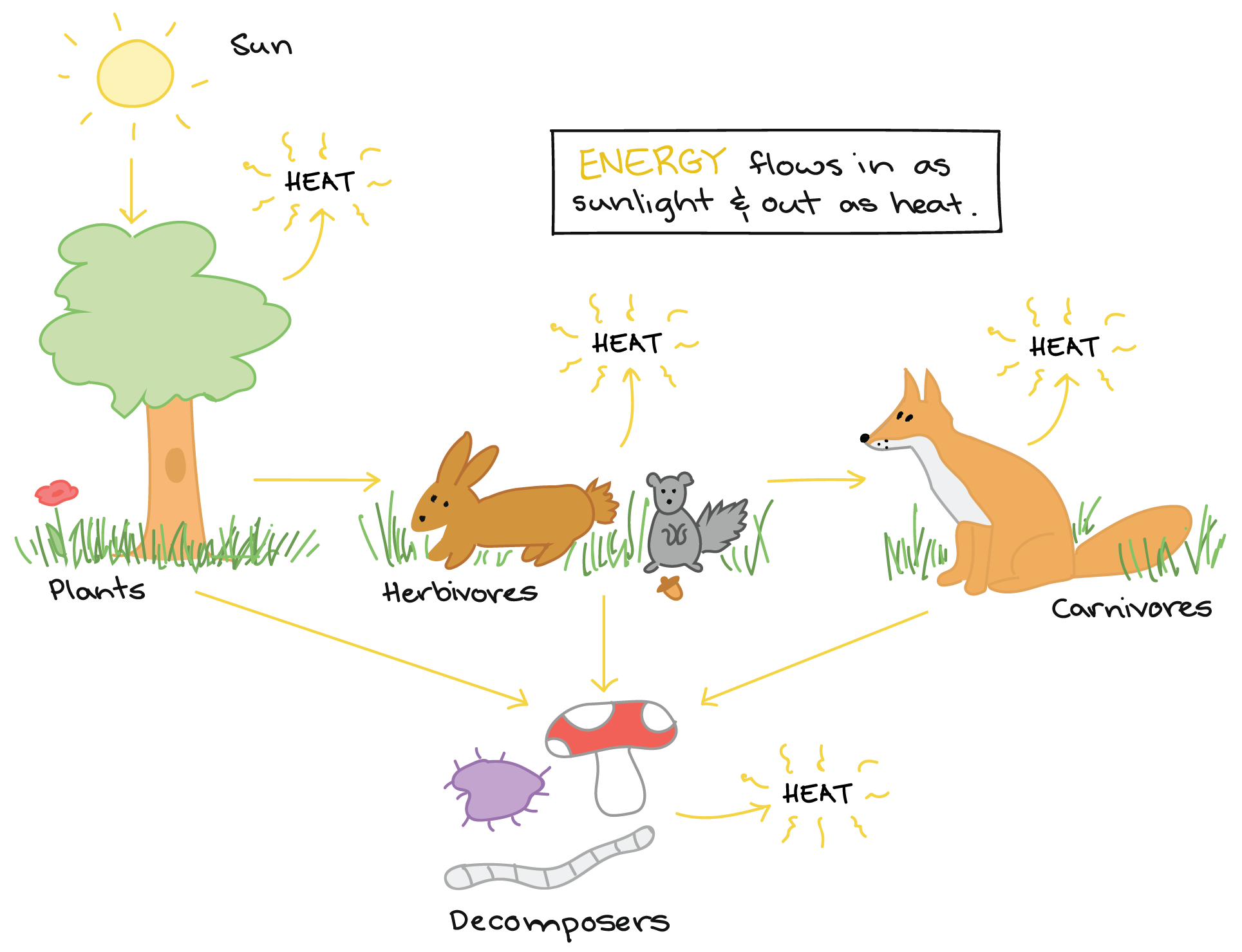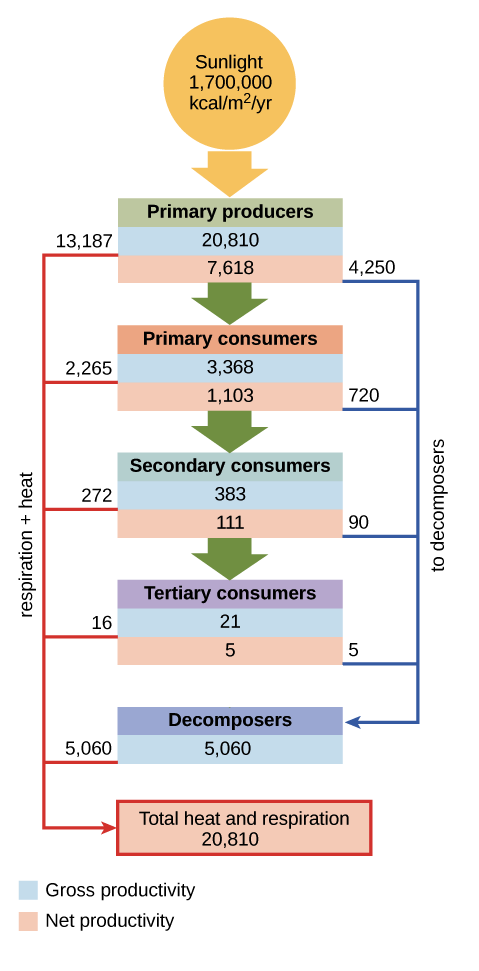Primary Productivity Is Best Described as
Complex networks of interconnected food chains in ecosystems are best described as. Both forests have the same gross primary productivity.

Energy Flow Primary Productivity Article Khan Academy
Select all answers that apply.

. Concepts and field methods. The 550 GtC of carbon in the global reservoir of plant biomass has a corresponding NPP of 60 GtC yr 1 which indicates that globally the average carbon residence time on land is approximately 9 years with an average biomass production NPP of 4 tCha 1 yr 1. How much of the earths primary productivity is being appropriated by humans.
B It is the amount of energy captured by autotrophs that results in an increase in plant biomass. Net primary production NPP is a measure of the annual productivity of the plants in the biosphere. To eliminate the need for subjective decisions by managem B.
Landscape ecology is best described as the study of A the array of interacting species within a community. Leave a Reply Cancel reply. A the energy fixed by photosynthesis B all.
Biomass is simply the amount of matter thats stored in the bodies of a group of organisms. 15 Scientists calculated the net primary productivity at two different forest sites. To determine operating leverage ent C.
Your email address will not be published. Net primary productivity is the amount of. A It is the balance between gross primary production and autotrophic respiration.
The goods are categorised into four categories. They show net primary productivity which is how much carbon dioxide vegetation takes in during photosynthesis minus how much carbon dioxide the plants release during respiration metabolizing sugars and starches for energy. Which of the following best describes gross primary productivity in an ecosystem.
This can be easily exhibited by a diagram known as an energy pyramid. In a food web the energy flows at different trophic levels from producers to consumers. Primary productivity refers to the degree to which autotrophic organisms primarily plants and algae convert energy into organic substances through photosynthesis or chemosynthesis.
B abiotic factors and the community of species that exist in a particular area. In general transformation process can be categorized as. Which of the following best describes gross primary productivity in an ecosystem.
Nearly all of Earths primary productivity is generated by photoautotrophs. Productivity can be defined for any trophic level or other group and it may take units of either energy or biomass. Net primary productivity is the amount of energy lost through respiration by producers added to the gross primary productivity of an ecosystem.
Gocke et al 2001. Net primary productivity is the amount of energy lost by producers through respiration over time. To allocate costs more accurately unity for getting a Which of the.
It principally occurs through the process of photosynthesis which uses light as its source of energy but it also occurs through chemosynthesis which uses the oxidation or reduction of inorganic chemical compounds as its source of energy. Agriculture is one of the industries that makes up the primary sector. Primary productivity in ecology the rate at which energy is converted to organic substances by photosynthetic producers photoautotrophs which obtain energy and nutrients by harnessing sunlight and chemosynthetic producers chemoautotrophs which obtain chemical energy through oxidation.
The primary production of phytoplankton has been estimated for decades by the 14 C Steemann-Nielsen 1952 and O 2 Gaarder and Gran 1927 methodsEven though the majority of the scientific community uses the 14 C method there have been others that have used the O 2 method as an alternative especially in developing countries eg. The primary transformation function provided by Mercy Hospital can best be described as. Which statement best describes the primary purpose of using standard costs.
Use or have students develop the equation below to calculate CO 2 uptake from. Primary productivity is the conversion of the suns energy into organic material through photosynthesis. To communicate performance expectations D.
Which of the following best describes the net primary productivity of an ecosystem. C It is the rate of primary production in an ecosystem. Net primary productivity can be defined as the amount of energy lost through respiration by producers subtracted from the gross primary.
Primary productivity is important because it is the process that forms the foundation of food webs in most ecosystems. Almost all life on Earth. What best describes a terrestrial ecosystem that will have the highest net primary productivity.
Primary productivity refers to the. Water nutrients and climate are favourable. Required fields are marked.
Net primary productivity is the amount of energy captured by producers through photosynthesis over time. How to calculate CO 2 uptakestorage from NPP data. Earthworms some insects and vultures are all examples of _____.
None of the above. It is the skill of producing raw food using farming techniques. Net primary production in forests.
Annual CO 2 uptake for your sample site can be calculated using simple math and a bit of chemistry knowledge. Primary productivity In ecology productivity is the rate at which energy is added to the bodies of organisms in the form of biomass. The food category includes eggs milk.
The presence of some forms of secondary energy can also help to increase the. Subtraction of which of the following will convert gross primary productivity into net primary productivity. The productivity of an ecosystem is defined as the rate of production of the amount of matter organic formed or evolved per unit area in timegross primary productivity is the defined as the rate at which the main chemical energy producers plants produces the chemical energy whereas net primary productivity is defined as the total amount of.
Accounting questions and answers. A high primary productivity rate in the ecosystems is obtained when the physical factors for instance. In ecology primary production is the synthesis of organic compounds from atmospheric or aqueous carbon dioxide.
Since the process of photosynthesis consumes carbon dioxide and produces oxygen it is of great importance to the environment. Despite the open oceans low net primary productivity NPP it produces more of the earths biomass per year than any other ecosystem or life zone. Raw materials textiles food and fuel.
Whether one measures the rate at which photosynthesis occurs or the rate at which the individual plant increases in mass one is concerned with primary production definition. The primary transformation function provided by Federal Express can best be described as. The synthesis and storage of organic molecules during the growth and reproduction of photosynthetic organisms.

Energy Flow Primary Productivity Article Khan Academy

Comments
Post a Comment